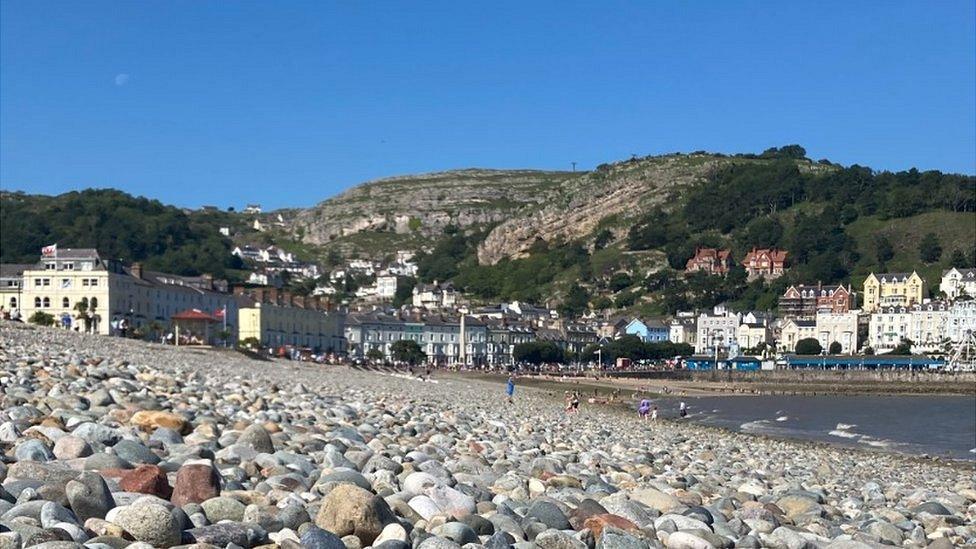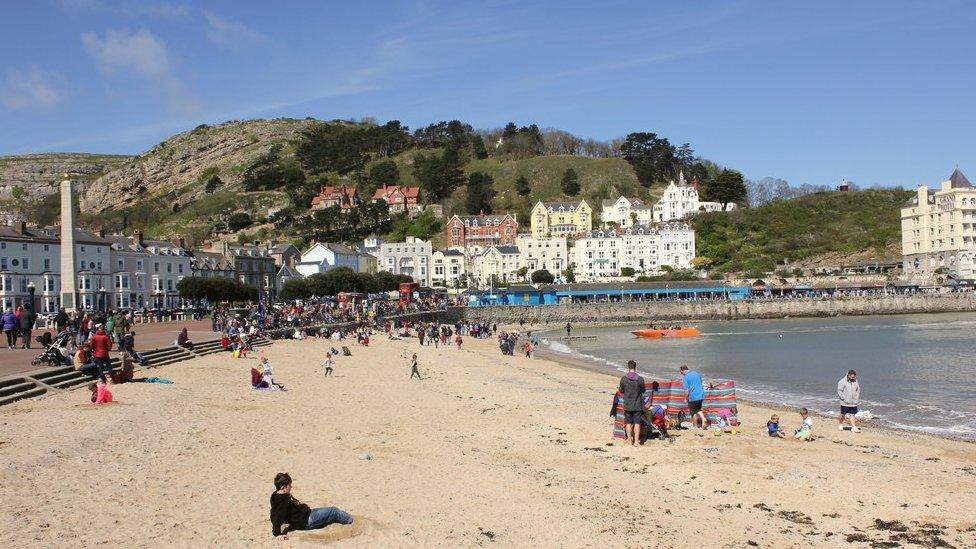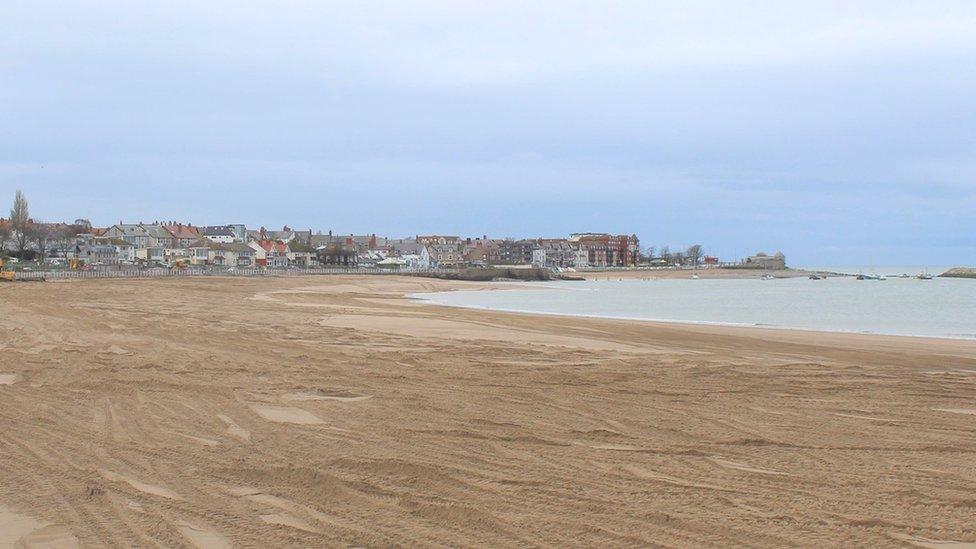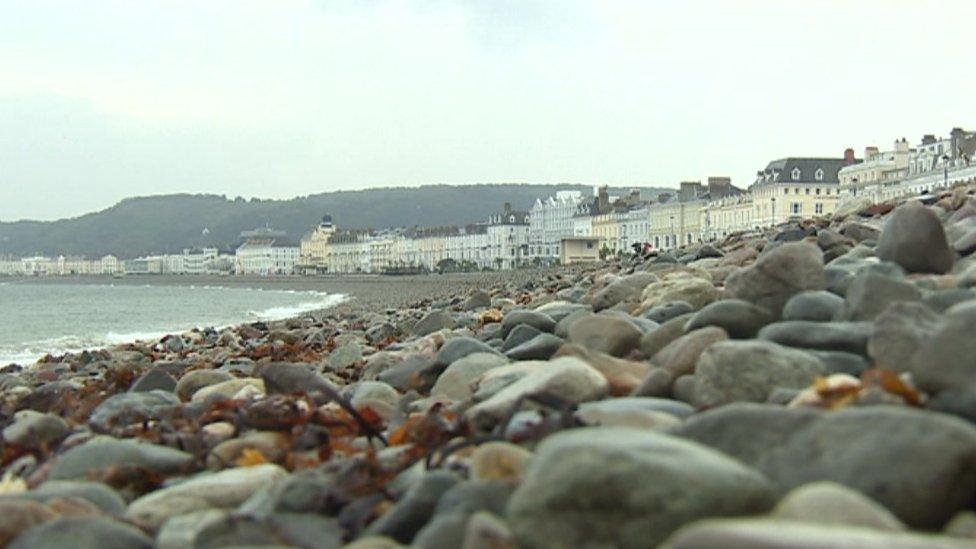Llandudno: Restoring sandy beach would boost resort, backers say
- Published

Rocks were added to Llandudno's North Shore Beach in 2014 as part of flood defences
Campaigners calling for the restoration of a sandy beach at a popular holiday resort say it is necessary to survive in the current economic climate.
About 50,000 tonnes of rock was dumped on Llandudno's North Shore Beach in 2014 as part of flood defences.
But opponents say losing the sand has had an adverse effect on the town.
Conwy council said it was seeking funding to hold a review on the "possible economic impact of replacing the cobbles with sand".
"The results of that study will help inform us on possible next steps," it said.
A petition calling for the removal of the rocks, external has now exceeded 10,000 names on the Welsh Parliament website, prompting it to be considered for a Senedd debate.

A small sandy section of the beach remains near Llandudno Pier
Councillor Ian Turner, who organised the petition, said he had "spoken to thousands of people in August" who asked him where the beach had gone.
"They're appalled by the state of it when they come here," he said.
Mr Turner said a sandy beach would boost not only the local economy but the whole of north Wales.
"Spend is down in Llandudno this summer, and I know we're not alone," he said.
"We need a sandy beach here to attract tourists to spend money and support the 5,000 jobs that depend on that sector.
"We need a sandy beach to survive. This is the last chance saloon."
He has the support of some businesses in the resort.
Jeff Lofthouse, who has been manager of the Imperial Hotel on the seafront since 1981, remembers the sandy beach and would welcome its return.
"A sandy beach has obviously got to be a plus for us," he said, adding that the pebbles had caused "unhappiness about the access to the beach" with some guests.
"This summer has been one of the worst for us that I can remember. I think the economic benefit of a sandy beach would be dramatic," he added.

Pier stallholder Bella McBryde says a sandy beach could "really boost our business"
It's not just the hotels that feel that way. Llandudno is home to Wales' longest pier where Bella McBryde runs a stall.
"I think sand would be really good because, obviously, it would draw a lot of people here and young families as well," she said.
"That would, hopefully, really boost our business here and everyone else in the town too."
Conwy council did originally back plans to remove the cobble bank along sections of the beach and replace it with sand.
But having been told by the Welsh government's Flood and Coastal Erosion Risk Management branch that it was too expensive, the council agreed to accept the funding available for a non-sand option.

What do residents and visitors think?
Resident Mette Byagur agreed that sand would be "nice" but said the most important thing was the impact on the environment.
"A sandy beach is better than stones but, for me, the biggest question is what is the natural environment here?
"If it's sand then it should be sandy, if it's rocks then keep the rocks. The ecosystem needs to be supported."

Visitor Anthony McLoughlin and resident Mette Byagur have different views
Anthony McLoughlin, who visits Llandudno, believes the resort would be "infinitely better" with a sandy beach.
"I'd certainly want to come here more frequently if it had a sandy beach because that's all that's really missing here," he said.

What does the Welsh government say?
The Welsh government said its "flood risk management budget aims to reduce risk to life and property and there are key things we consider before approving funding".
"These include the level of flood protection afforded to the community, associated environmental and carbon impacts and value for money," it said.
"We consider the cost effectiveness of every business case and prioritise funding accordingly.
"This allows us to distribute investment fairly across the communities that are at risk of flooding."
Related topics
- Published9 April 2023

- Published9 June 2021

- Published28 September 2017
